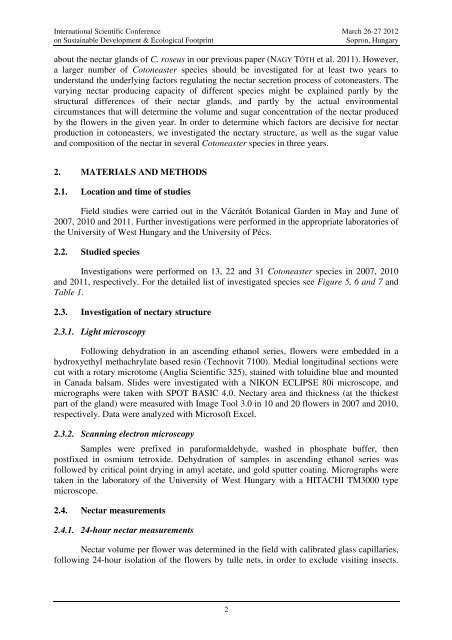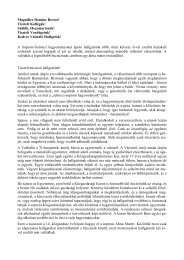Floral Nectar Production and Nectar Sugar Composition of ...
Floral Nectar Production and Nectar Sugar Composition of ...
Floral Nectar Production and Nectar Sugar Composition of ...
You also want an ePaper? Increase the reach of your titles
YUMPU automatically turns print PDFs into web optimized ePapers that Google loves.
International Scientific Conference March 26-27 2012<br />
on Sustainable Development & Ecological Footprint Sopron, Hungary<br />
about the nectar gl<strong>and</strong>s <strong>of</strong> C. roseus in our previous paper (NAGY TÓTH et al. 2011). However,<br />
a larger number <strong>of</strong> Cotoneaster species should be investigated for at least two years to<br />
underst<strong>and</strong> the underlying factors regulating the nectar secretion process <strong>of</strong> cotoneasters. The<br />
varying nectar producing capacity <strong>of</strong> different species might be explained partly by the<br />
structural differences <strong>of</strong> their nectar gl<strong>and</strong>s, <strong>and</strong> partly by the actual environmental<br />
circumstances that will determine the volume <strong>and</strong> sugar concentration <strong>of</strong> the nectar produced<br />
by the flowers in the given year. In order to determine which factors are decisive for nectar<br />
production in cotoneasters, we investigated the nectary structure, as well as the sugar value<br />
<strong>and</strong> composition <strong>of</strong> the nectar in several Cotoneaster species in three years.<br />
2. MATERIALS AND METHODS<br />
2.1. Location <strong>and</strong> time <strong>of</strong> studies<br />
Field studies were carried out in the Vácrátót Botanical Garden in May <strong>and</strong> June <strong>of</strong><br />
2007, 2010 <strong>and</strong> 2011. Further investigations were performed in the appropriate laboratories <strong>of</strong><br />
the University <strong>of</strong> West Hungary <strong>and</strong> the University <strong>of</strong> Pécs.<br />
2.2. Studied species<br />
Investigations were performed on 13, 22 <strong>and</strong> 31 Cotoneaster species in 2007, 2010<br />
<strong>and</strong> 2011, respectively. For the detailed list <strong>of</strong> investigated species see Figure 5, 6 <strong>and</strong> 7 <strong>and</strong><br />
Table 1.<br />
2.3. Investigation <strong>of</strong> nectary structure<br />
2.3.1. Light microscopy<br />
Following dehydration in an ascending ethanol series, flowers were embedded in a<br />
hydroxyethyl methachrylate based resin (Technovit 7100). Medial longitudinal sections were<br />
cut with a rotary microtome (Anglia Scientific 325), stained with toluidine blue <strong>and</strong> mounted<br />
in Canada balsam. Slides were investigated with a NIKON ECLIPSE 80i microscope, <strong>and</strong><br />
micrographs were taken with SPOT BASIC 4.0. <strong>Nectar</strong>y area <strong>and</strong> thickness (at the thickest<br />
part <strong>of</strong> the gl<strong>and</strong>) were measured with Image Tool 3.0 in 10 <strong>and</strong> 20 flowers in 2007 <strong>and</strong> 2010,<br />
respectively. Data were analyzed with Micros<strong>of</strong>t Excel.<br />
2.3.2. Scanning electron microscopy<br />
Samples were prefixed in paraformaldehyde, washed in phosphate buffer, then<br />
postfixed in osmium tetroxide. Dehydration <strong>of</strong> samples in ascending ethanol series was<br />
followed by critical point drying in amyl acetate, <strong>and</strong> gold sputter coating. Micrographs were<br />
taken in the laboratory <strong>of</strong> the University <strong>of</strong> West Hungary with a HITACHI TM3000 type<br />
microscope.<br />
2.4. <strong>Nectar</strong> measurements<br />
2.4.1. 24-hour nectar measurements<br />
<strong>Nectar</strong> volume per flower was determined in the field with calibrated glass capillaries,<br />
following 24-hour isolation <strong>of</strong> the flowers by tulle nets, in order to exclude visiting insects.<br />
2





